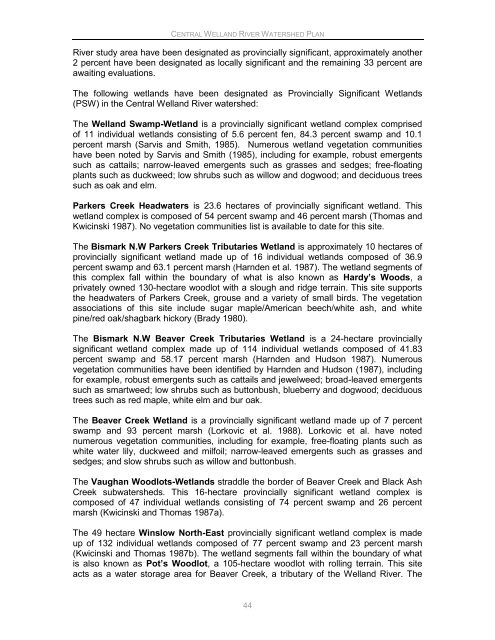Central Welland River Watershed Plan - Niagara Peninsula ...
Central Welland River Watershed Plan - Niagara Peninsula ...
Central Welland River Watershed Plan - Niagara Peninsula ...
- No tags were found...
You also want an ePaper? Increase the reach of your titles
YUMPU automatically turns print PDFs into web optimized ePapers that Google loves.
CENTRAL WELLAND RIVER WATERSHED PLAN<strong>River</strong> study area have been designated as provincially significant, approximately another2 percent have been designated as locally significant and the remaining 33 percent areawaiting evaluations.The following wetlands have been designated as Provincially Significant Wetlands(PSW) in the <strong>Central</strong> <strong>Welland</strong> <strong>River</strong> watershed:The <strong>Welland</strong> Swamp-Wetland is a provincially significant wetland complex comprisedof 11 individual wetlands consisting of 5.6 percent fen, 84.3 percent swamp and 10.1percent marsh (Sarvis and Smith, 1985). Numerous wetland vegetation communitieshave been noted by Sarvis and Smith (1985), including for example, robust emergentssuch as cattails; narrow-leaved emergents such as grasses and sedges; free-floatingplants such as duckweed; low shrubs such as willow and dogwood; and deciduous treessuch as oak and elm.Parkers Creek Headwaters is 23.6 hectares of provincially significant wetland. Thiswetland complex is composed of 54 percent swamp and 46 percent marsh (Thomas andKwicinski 1987). No vegetation communities list is available to date for this site.The Bismark N.W Parkers Creek Tributaries Wetland is approximately 10 hectares ofprovincially significant wetland made up of 16 individual wetlands composed of 36.9percent swamp and 63.1 percent marsh (Harnden et al. 1987). The wetland segments ofthis complex fall within the boundary of what is also known as Hardy’s Woods, aprivately owned 130-hectare woodlot with a slough and ridge terrain. This site supportsthe headwaters of Parkers Creek, grouse and a variety of small birds. The vegetationassociations of this site include sugar maple/American beech/white ash, and whitepine/red oak/shagbark hickory (Brady 1980).The Bismark N.W Beaver Creek Tributaries Wetland is a 24-hectare provinciallysignificant wetland complex made up of 114 individual wetlands composed of 41.83percent swamp and 58.17 percent marsh (Harnden and Hudson 1987). Numerousvegetation communities have been identified by Harnden and Hudson (1987), includingfor example, robust emergents such as cattails and jewelweed; broad-leaved emergentssuch as smartweed; low shrubs such as buttonbush, blueberry and dogwood; deciduoustrees such as red maple, white elm and bur oak.The Beaver Creek Wetland is a provincially significant wetland made up of 7 percentswamp and 93 percent marsh (Lorkovic et al. 1988). Lorkovic et al. have notednumerous vegetation communities, including for example, free-floating plants such aswhite water lily, duckweed and milfoil; narrow-leaved emergents such as grasses andsedges; and slow shrubs such as willow and buttonbush.The Vaughan Woodlots-Wetlands straddle the border of Beaver Creek and Black AshCreek subwatersheds. This 16-hectare provincially significant wetland complex iscomposed of 47 individual wetlands consisting of 74 percent swamp and 26 percentmarsh (Kwicinski and Thomas 1987a).The 49 hectare Winslow North-East provincially significant wetland complex is madeup of 132 individual wetlands composed of 77 percent swamp and 23 percent marsh(Kwicinski and Thomas 1987b). The wetland segments fall within the boundary of whatis also known as Pot’s Woodlot, a 105-hectare woodlot with rolling terrain. This siteacts as a water storage area for Beaver Creek, a tributary of the <strong>Welland</strong> <strong>River</strong>. The44
















